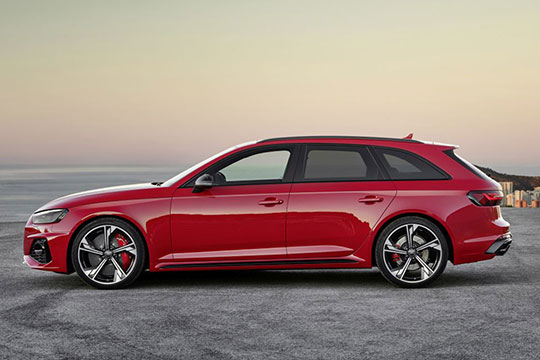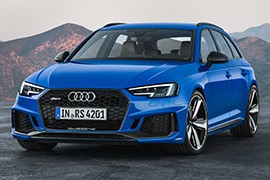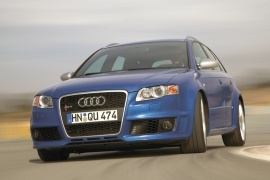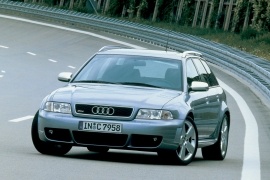AUDI RS 4 Avant Models/Series Timeline, Specifications & Photos
First production year: 2000
Engines: Gasoline
Body style: Wagon (station wagon, estate, combi, touring)
Even if the previous RS4 Avant offered the same power and torque as the 2020 model year, Audi fitted the newer version with a gasoline particulate filter and a twin-turbo V6 unit.
In January 2021, all new cars had to fit in the Euro 6d norms, and that was a problem for most car-makers, especially those who had more powerful vehicles. The new standards were tighter and imposed new safety features and lower emissions.
Along with the technical upgrades, Audi refreshed the exterior look of the RS4 Avant. The new headlights showed a different style, especially on their lower side. The singleframe grille design was extended to the lower part of the bumper, and a pair of air-scoops channeled the air-flow to the front discs and intercoolers. The marketing department added the option of badge deletion so that the RS4 could become a real sleeper.
The interior design offered a new perspective for the driver with a new Audi Virtual Cockpit design and a new 10.1” infotainment touch-screen for the MMI system. The LED doors contour amplified the look of the black-only interior. Audi fit more safety features to the car than the Euro 6d norms requested.
The powerplant was the biggest innovation. Instead of the older, 4.2-liter V8, the engineers installed a 2.9-liter V6 engine that offered 450 hp. It was paired as standard to a 9-speed automatic transmission, and, as usual, it sent the power in all corners via a Torsen center differential.
AUDI RS4 Avant (B9) 2.9L V6 TFSI quattro tiptronic 8AT (450 HP)
Audi revealed the fifth generation of the A4 in 2015, but its hard-core fans awaited that particular version that went under the radar: the family-looking station wagon that came with an RS badge on it.
Usually, the station wagons are those cars that block the left lane and are crawling with all seats taken. Also, they are often seen on the HOV lanes doing lower-than-limit speed on the highway. But there are some exceptions. Some of these family-friendly vehicles worth every penny, such as the Audi RS6 or its little brother, the RS4.
Unlike its regular, non-RS versions, the RS4 Avant looked meaner. The front fascia featured a black singleframe grille with a red and silver badge on it and a piano-black lower lip under the apron. Its LED headlights featured a double, reversed-L shape daytime running light signature. Audi installed black side sills and door mirrors to emphasize the special version, while at the back, besides the roof-spoiler, it added two oval-shaped pipes under the bumper, flanking a diffuser. But all these details might still get unnoticed by the boys in blue due to the car's overall shape.
Inside, Audi went wild and installed all the good things it had in its parts bins. At the front, the carmaker installed sport bucket seats with integrated headrests embroidered with the RS4 logo on their seatbacks. The carbon-fiber trims from the center console and dashboard evoked a racy spirit, while the Audi Cockpit digital instrument cluster spoiled the driver. A second screen stood on top of the center stack, controlled via the MMI controller next to the gear-selector.
But the most crucial change was under the hood, where Audi dropped the previously used 4.2-liter V-8 engine and replaced it with a twin-turbocharged 2.9-liter V-6. While the power remained the same, the torque went up by 170 Nm (125 lb-ft). The gearbox gained another gear. With all these changes made, the 2017 2.9-liter V-6 was quicker than its predecessor by more than half of second on the 0-100 kph (0-62 mph) run.
The third generation of the RS4 was offered exclusively as a station-wagon, following the path taken by its bigger brother, the RS6. It was a sports-car for a whole family and its luggage.
The car was designed to convince people that a station-wagon can be fun to drive, regardless of its exterior shape. The RS4 drivetrain was installed on the A5 as well so if someone didn't need that extra trunk, the RS5 was another option.
The exterior was enhanced when compared to the standard Audi A4 Avant. The wider wheel-fenders, the lowered front apron with silver lip-spoiler, and the silver door-mirrors emphasized the sporty character of the car. To handle better, the suspension was lowered by 20 mm (0.79”), and a set of 19” wheels were fitted as standard. A 20” light-alloy wheels were offered as an option.
Inside, there were only a few details that could differentiate a well-equipped A4 Avant from an RS4. On the instrument cluster, there was an RS4 badge in the tachometer, some aluminum trims were installed and that was it. The S-Sport seats covered in black leather and Alcantara are standard on the top trim level. Sport-bucket seats are offered as an option.
The most important aspect of the RS4 was the drivetrain. Under the hood, there was a 4.2-liter V8 naturally aspirated engine. It offered 450 hp and its red-line was at 8200 rpm. It was mated as standard to a 7-speed S-Tronic transmission. A sport package option added 20” light-alloy wheels, a rear sports differential, and an adaptive suspension that could transform the car into a track-ready weapon or a comfortable ride for the entire family.
Audi RS4 jumped an entire generation of the Audi A4, on which it was based. Since there was no RS version for the B6, the B7 was the second generation of the fastest A4.
The 2006 RS4 Avant was the station-wagon version of the Audi RS4 Sedan. Since there was no competitor from the BMW in that segment, the car was well received by those who were looking for an all-wheel-drive, performant premium compact station-wagon.
The car featured the big single-frame grille taken from the Audi A8 and it was extended to the lowest part of the bumper. On its sides, there were two air-scoops to cool the brakes. Inside the wide openings on the front bumper, there were the fog-lights. The flared wheel-arches were easy to spot and to differentiate the RS4 from a standard A4 Avant. To improve the car's mass distribution, it featured aluminum front fenders and hood. Even though, the car had a hefty 1710 kg (3770 lbs), due to its large, V8 engine.
Inside, there were badges to tell about the car's version embodied on the seats and on the steering wheel. The flat-bottom steering wheel was garnished with aluminum parts to enhance the sporty feel of the car. The carbon-fiber trims around the dashboard and on the center console left no mistake about the car's intention of performance, not to mention that it was available only with a 6-speed manual. The rear passengers could enjoy the comfortable seats, especially from the outboard. Through the middle of the floor, there was the center tunnel needed for the all-wheel-drive system.
Under the hood, there was a naturally aspirated V8 engine. It was the last naturally aspirated Audi RS4.
Audi introduced in 1999 the most powerful version of the A4 lineup, and it was available exclusively as a station wagon, a shape that, in the German automaker's inventory, wore the Avant nameplate.
Created as an alternative for go-fast vehicles such as the BMW M3, the RS4 Avant was the legit successor for the RS2 that thrilled customers in the early '90s. Unlike its predecessor, which was developed together with Porsche, this model was developed together with the British specialist Cosworth Technologies, which was responsible for creating successful racing cars. As a result, the RS4 Avant became the fastest compact vehicle on the market, threatening with its performance even some supercars from that era. After all, there were not too many cars able to hit 62 mph (100 kph) from a dig in less than five seconds.
While the overall shape of the car was similar to the regular A4 Avant, the RS4 version was clearly different. Its front and rear fenders were wider to accommodate the fat 255/55 tires wrapped around bespoke 18" forged light-alloy wheels. At the front, the redesigned bumper featured a new apron that had a broad center grille flanked by a pair of scoops that housed the fog lamps. Furthermore, on the bumper's sides, the automaker added extracting vents to lower the aerodynamic lift. A set of side skirts continued the flared wheel arches, while at the back, Audi placed a redesigned bumper fitted with a diffuser. Underneath it, a twin elliptic exhaust peaked.
Inside, the leather-wrapped interior greeted its driver and side passenger with Recaro high-bolstered sports seats. These were separated by a folding center armrest where Audi placed a small storage compartment. A low-mounted center console housed the gear stick and the handbrake. On the center stack, a new infotainment system with navigation and phone connectivity was available. Fronting the driver was a three-spoke steering wheel adorned by an RS4 badge on the lower spoke. The same logo was imprinted inside the tachometer's dial from the instrument cluster, and next to it was a speedometer marked to 310 kph (193 mph).
In the back, Audi installed a split-folding (60/40) bench seat made mostly for two adults since the transmission tunnel that crossed the car from front to back was tall. Still, there was enough room for adult-sized occupants. But the RS4 Avant was also a practical car. The seatback of the bench seat could expand the trunk space up to 1,783-liter (63 cu-ft) from its regular 915-liter (32.3 cu-ft.) size with the rear seats up.
Still, the rear magic happened under the car's skin. The stiffened and lowered suspension allowed the RS4 Avant to run faster than any of its stablemates. Still, due to a gentleman's agreement, the car's speed was capped at 155 mph (250 kph). But it could get there very fast thanks to its twin-turbocharged 2.7-liter V6, a powerplant that was introduced a few years before. The six-speed manual gearbox sent the power in all corners via a mechanical AWD system and an electronically-controlled rear differential.




